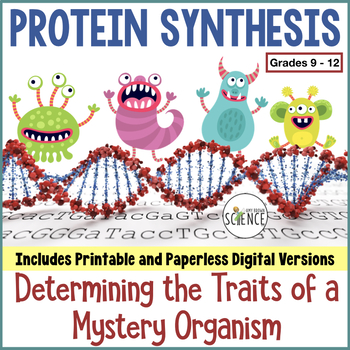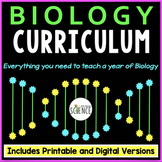Protein Synthesis Translation Activity
- Zip
- Google Apps™

What educators are saying
Also included in
- This complete teaching unit on DNA, RNA, and Protein Synthesis includes everything you need to teach this unit to your life science or biology students. Resources include a 120-slide PowerPoint presentation packed with colorful and interesting photographs and images, teacher notes, printable and diPrice $49.99Original Price $67.95Save $17.96
- Nothing generates excitement like a great lab activity. Whether the topic is cells, biochemistry, genetics, mitosis, or the compound microscope, these 15 Must-Do Labs will ensure your students master the concepts. From DNA to dichotomous keys to enzymes, this bundle provides quality lab activities oPrice $35.99Original Price $49.99Save $14.00
- This NO PREP, PRINTABLE, EDITABLE, AND DIGITAL Biology Curriculum contains everything you need for an entire year of Biology! For less than $3 a day, you can save your time, energy, and sanity. Each of the 20 Complete Units includes a teaching PowerPoint presentation, notes, labs, homework assignmenPrice $525.00Original Price $988.18Save $463.18
Description
This activity is designed to help our students master the concepts of transcription and translation. The details of these concepts are very difficult for many of our students. This activity provides a visual method of teaching students how the information stored in DNA produces traits and characteristics in living organisms. Using a DNA template, students will transcribe mRNA, and translate the information to create a “mystery organism.” Choose to use the traditional printable version, or the paperless, digital Google Apps version.
This resource is perfect for distance learning and for students in 1:1 classrooms.
Click this link to view all of my Digital Resources.
Protein Synthesis: Determining the Traits of a Mystery Organism Through Translation and Protein Synthesis. This fun DNA and RNA activity teaches students how to read the code of messenger RNA codons and translate the code to determine the proteins that are made to produce the characteristics of a "mystery organism." The student must determine which proteins will be made to produce the mystery organism. By simulating the process of protein synthesis, the traits of the organism will be determined.
What is included in your download folder?
- Printable and Editable 6-Page Student Handout
- Printable and Editable Paper Saving Version
- Paperless Digital Version for Google Drive, Google Classroom, and/or Microsoft OneDrive
- Teacher Guide and Answer Key
Many times students have trouble with the concepts involved in protein synthesis. This is a fun activity that reinforces transcription and translation. Students are given a DNA template and must determine the complementary mRNA codon sequence, tRNA anticodon sequence, and the amino acid sequence. The order of the amino acids will determine the traits in the "mystery organism."
This activity is suitable for biology students in grades 9-12.
Materials Needed: Colored Pencils and Paper
The included Teacher Guide contains pre-lab discussion, answers to all questions, and some post lab follow up ideas.
Related products include:
DNA, RNA, and Protein Synthesis Complete Teaching Bundle
Biology Buzz Words: DNA, RNA, and Protein Synthesis
DNA, RNA, and Protein Synthesis PowerPoint and Notes Set
DNA, RNA, and Protein Synthesis Warm Ups and Bell Ringers
Test: DNA, RNA, Protein Synthesis
DNA, RNA, and Protein Synthesis Study Guide
DNA, RNA and Protein Synthesis Crossword Puzzle
Translation and Protein Synthesis Crossword Puzzle
DNA, RNA, and Protein Synthesis Google Sheets Hidden Picture Reveal Games
DNA, RNA, Protein Synthesis Set of 4 Homework Assignments
Homework #1: The Basics of DNA
Homework #3: RNA and Transcription
Homework #4: Protein Synthesis and Translation
DNA, RNA, Protein Synthesis - Set of 3 quizzes
Quiz #2: RNA and Transcription
Quiz #3: Translation and Protein Synthesis
RNA and Transcription Powerpoint Jeopardy Review Game
Translation and Protein Synthesis Powerpoint Jeopardy Review Game
DNA and RNA Powerpoint Jeopardy Review Games - Set of Three Games
FREE Chart of Amino Acids and Their Codons
Free DNA Informational Text with Graphic Organizers
For updates about sales and new products, please follow my store:







